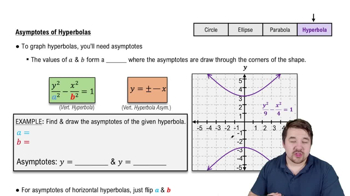Sketch the graphs of y = cosh x, y = sinh x, and y = tanh x (include asymptotes), and state whether each function is even, odd, or neither.
Table of contents
- 0. Functions7h 54m
- Introduction to Functions16m
- Piecewise Functions10m
- Properties of Functions9m
- Common Functions1h 8m
- Transformations5m
- Combining Functions27m
- Exponent rules32m
- Exponential Functions28m
- Logarithmic Functions24m
- Properties of Logarithms36m
- Exponential & Logarithmic Equations35m
- Introduction to Trigonometric Functions38m
- Graphs of Trigonometric Functions44m
- Trigonometric Identities47m
- Inverse Trigonometric Functions48m
- 1. Limits and Continuity2h 2m
- 2. Intro to Derivatives1h 33m
- 3. Techniques of Differentiation3h 18m
- 4. Applications of Derivatives2h 38m
- 5. Graphical Applications of Derivatives6h 2m
- 6. Derivatives of Inverse, Exponential, & Logarithmic Functions2h 37m
- 7. Antiderivatives & Indefinite Integrals1h 26m
- 8. Definite Integrals4h 44m
- 9. Graphical Applications of Integrals2h 27m
- 10. Physics Applications of Integrals 3h 16m
- 11. Integrals of Inverse, Exponential, & Logarithmic Functions2h 34m
- 12. Techniques of Integration7h 41m
- 13. Intro to Differential Equations2h 55m
- 14. Sequences & Series5h 36m
- 15. Power Series2h 19m
- 16. Parametric Equations & Polar Coordinates7h 58m
6. Derivatives of Inverse, Exponential, & Logarithmic Functions
Derivatives of Exponential & Logarithmic Functions
Problem 7.3.12
Textbook Question
11–15. Identities Prove each identity using the definitions of the hyperbolic functions.
tanh(−x) = −tanh x
 Verified step by step guidance
Verified step by step guidance1
Step 1: Recall the definition of the hyperbolic tangent function: .
Step 2: Substitute into the definition of . This gives: .
Step 3: Factor out from the numerator of the fraction: .
Step 4: Recognize that the numerator is the negative of the numerator in the definition of . Thus, .
Step 5: Conclude that the identity is proven using the definition of hyperbolic functions.
 Verified video answer for a similar problem:
Verified video answer for a similar problem:This video solution was recommended by our tutors as helpful for the problem above
Video duration:
5mPlay a video:
Was this helpful?
Key Concepts
Here are the essential concepts you must grasp in order to answer the question correctly.
Hyperbolic Functions
Hyperbolic functions are analogs of trigonometric functions but are based on hyperbolas rather than circles. The primary hyperbolic functions include sinh(x), cosh(x), and tanh(x), which are defined as sinh(x) = (e^x - e^(-x))/2, cosh(x) = (e^x + e^(-x))/2, and tanh(x) = sinh(x)/cosh(x). Understanding these definitions is crucial for proving identities involving hyperbolic functions.
Recommended video:

Asymptotes of Hyperbolas
Odd and Even Functions
An odd function is defined by the property f(-x) = -f(x), while an even function satisfies f(-x) = f(x). The hyperbolic tangent function, tanh(x), is an odd function, which means that tanh(-x) = -tanh(x). This property is essential for proving identities involving tanh, as it allows for simplifications when substituting negative arguments.
Recommended video:

Properties of Functions
Proof Techniques in Calculus
Proof techniques in calculus often involve direct substitution, algebraic manipulation, and the application of definitions. To prove identities like tanh(−x) = −tanh x, one typically starts with the left-hand side, applies the definition of tanh, and uses properties of exponents and odd functions to arrive at the right-hand side. Mastery of these techniques is vital for successfully demonstrating mathematical identities.
Recommended video:

Fundamental Theorem of Calculus Part 1

 4:50m
4:50mWatch next
Master Derivatives of General Exponential Functions with a bite sized video explanation from Patrick
Start learningRelated Videos
Related Practice
Textbook Question
15
views
